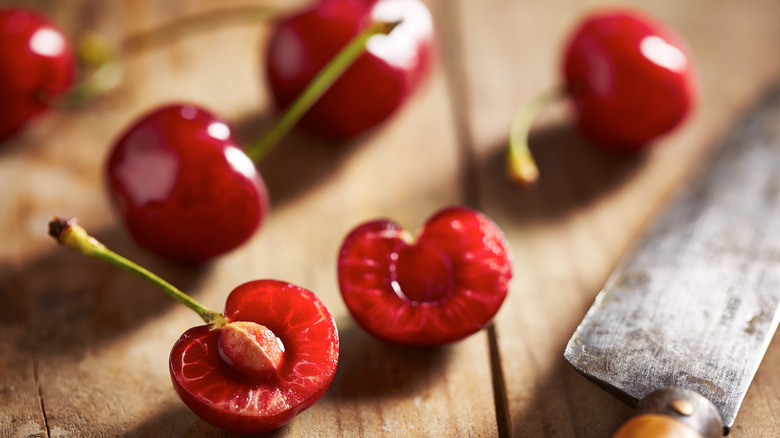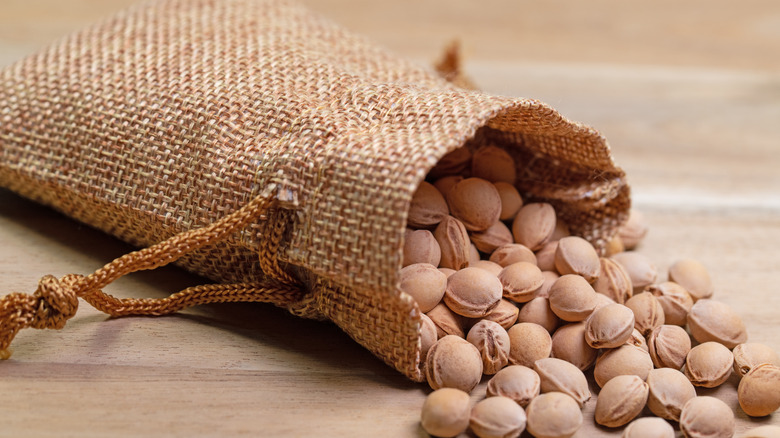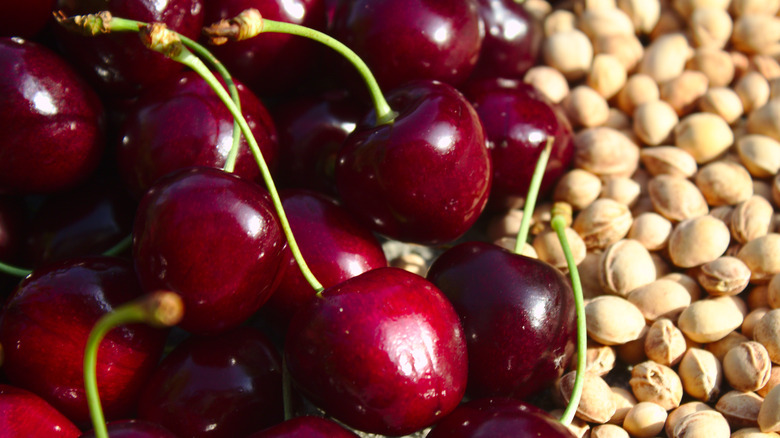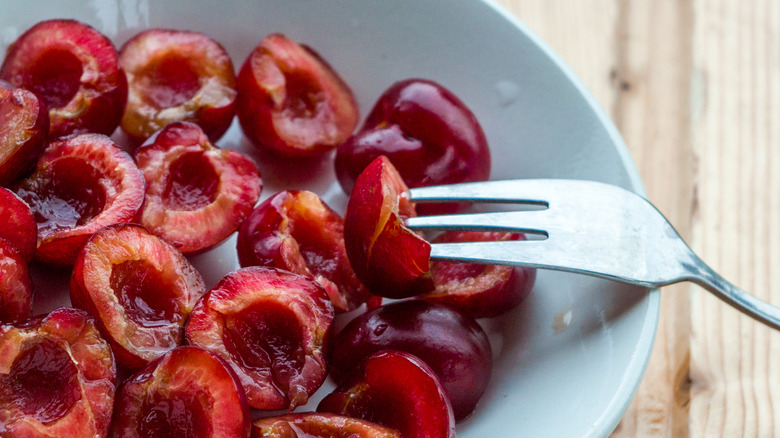What Happens To Your Body If You Swallow A Cherry Pit
Cherries are a tasty and versatile summer fruit that contain a variety of essential vitamins and minerals (via Everyday Health). Not only can they be a delicious and nutritious snack, but they can also be used in a variety of desserts and dishes. That's because there are two main types of cherries: sweet cherries and tart cherries. While sweet cherries can be eaten just as they are, tart cherries are typically reserved for cooking and baking.
Both sweet and tart cherries, however, are full of nutrients that can help benefit your overall health. "Cherries are a good source of healthy compounds like fiber, vitamin C, potassium, and polyphenols," Samantha Heller, a New York City-based registered dietitian, told Everyday Health. These nutrients can help reduce inflammation and lower your risk of disease. While cherries are certainly not a cure-all, they are considered a superfood that can enrich your diet and promote health and well-being.
Swallowing cherry pits is a choking hazard
Like plums and apricots, cherries are a type of fleshy stone fruit. According to Healthline, stone fruits contain seeds in the center of the fruit, which is enclosed by a hard pit, also known as a stone. While cherry pits are supposed to be spit out, they are sometimes swallowed by accident. While it is not uncommon, it can pose a risk to young children, especially those who are not used to eating cherries and other stone fruits.
Depending on the size of the pit, they can be a choking hazard for kids and even some adults. That's because cherry pits can obstruct your airway and get stuck in the back of your throat, which can lead to choking. As a result, the biggest risk or concern about cherry pits is accidentally swallowing and choking on them, especially for small children, which is why it's best to make sure they're out of reach.
Are cherry pits poisonous?
As it turns out, cherry pits contain a substance known as amygdalin, according to MedicineNet. Amygdalin is a chemical that reacts with the enzymes in your saliva, which your body then converts into hydrogen cyanide when consumed. Hydrogen cyanide, or simply cyanide, is a toxic compound that can deprive your body of oxygen and damage your vital organs. In order for cyanide to be released from the cherry pit, however, it needs to be crushed or chewed.
While chewing a single cherry pit is not a cause for concern, chewing and swallowing several pits can potentially be dangerous, especially for children. Although each cherry pit contains only a small amount of amygdalin that can later be converted into cyanide, chewing and swallowing several can increase your risk of cyanide toxicity. That's why it's important to watch out for common signs and symptoms of cyanide toxicity, which include headache, confusion, dizziness, gastritis, vomiting, and heavy anxiety, among others.
Cherry pits can't be digested
As it turns out, cyanide toxicity is not a concern if the cherry pit is swallowed whole, according to experts at MedicineNet. However, that's because cherry pits are indigestible. That means that your body will not be able to digest cherry pits, but they will likely pass on their own. Cherry pits cannot be broken down in the digestive system, unlike the fleshy part of the fruit.
Instead, they remain completely whole and intact when they pass through your esophagus and gastrointestinal tract and will most likely come out when you use the toilet. It is only when the pits are crushed or chewed that they pose a potential risk to your health. While it is a choking hazard and should still be avoided, accidentally swallowing a cherry pit will not harm you or increase your risk of cyanide poisoning. It will simply pass right through you.
What to do if you've swallowed a cherry pit
If you or your child has swallowed a cherry pit whole, there's no need to panic. Unless you or your child starts choking on it, swallowing a whole cherry pit or two is relatively harmless (via Healthline). If the pit is bruised, cracked, crushed, or chewed in any way before it is swallowed, however, the amygdalin inside of it will be released and converted into cyanide in your body. Nevertheless, you would need to chew and swallow quite a few cherry pits in order for this to pose a severe risk to your health.
For example, red cherry pits contain 3.9 miligrams of amygdalin per gram of fruit. Depending on the type of pit eaten, this can produce anywhere from 0.01 to 1.1 milligrams of hydrogen cyanide inside your body. You may be at risk for cyanide toxicity if 0.2 to 1.6 milligrams of hydrogen cyanide per pound of body weight is present in the body. Using the red cherry pit example, chewing and swallowing anywhere from seven to nine pits can pose potential harm. This number is much lower for children, however. If your child has accidentally chewed and swallowed multiple cherry pits and you start to see symptoms develop, you should seek immediate medical attention.
How to prevent cherry pits from being swallowed
That's why it's important to make sure cherry pits are never chewed or swallowed in the first place. According to experts at LiveStrong, the best way to prevent kids from accidentally swallowing cherry pits is by keeping them out of reach. As it turns out, you can do this by using a tool to remove the pits from the cherries before giving the fruit to your child to eat. If they're old enough, you can even teach them how to spit out the pits on their own when they're eating cherries.
Regardless of age, however, it's always best to spit out the pits when snacking on cherries. Accidentally swallowing one is nothing to worry about, but this should be avoided if possible. Keep in mind to do this even when using cherries in any recipe, such as blending them in a fresh morning smoothie or baking cherry pies.






